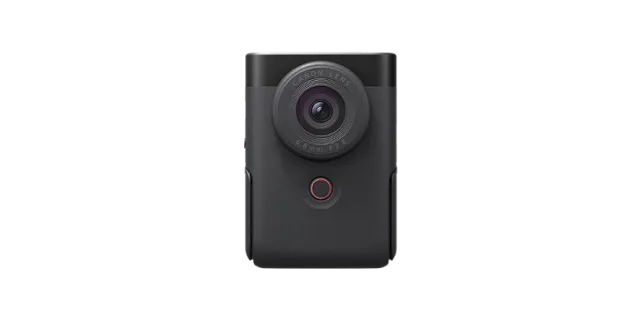Canon's recent introduction of the PowerShot V10 aims to capture the attention of vloggers and video creators seeking an alternative to smartphones. This compact camera offers a unique form factor and beginner-friendly features. While it holds potential as a portable vlogging tool, it falls short in certain aspects compared to its competitors.
Design and Features:
The PowerShot V10 features a compact and ergonomic design, making it comfortable to hold for extended periods. Its vertical grip and large record button cater to vloggers, simplifying the recording process. The camera's two-inch flip-up screen allows for traditional behind-the-camera shooting, enhancing versatility. Moreover, it offers 4K 30 fps and 1080p 60 fps video recording capabilities, along with a kickstand for stationary recording. The presence of a microphone array optimized for video creators and USB Type-C connectivity for use as a webcam are notable features that set it apart from some rivals.
Limitations:
Despite its appeal, the PowerShot V10 suffers from certain limitations that may deter potential buyers. The camera's 20.9 MP sensor falls short in comparison to competitors offering larger sensors, such as APS-C and Micro Four Thirds systems. One-inch sensors have made progress, but they struggle to match the computational photography advancements seen in smartphones. Additionally, the absence of optical image stabilization is a drawback, as it restricts the camera's ability to produce smooth footage, especially when compared to other compact cameras and smartphones in the same price range. Moreover, the V10 lacks manual controls, limiting creative possibilities for advanced users. The omission of 8-bit colors in the Rec.709 color space for video recording is another disappointment for a camera targeted towards video-centric users.
Competition:
In a highly competitive market, the PowerShot V10 faces strong rivals. Smartphones, armed with computational photography techniques, compensate for their smaller sensors and offer convenience. However, for those willing to invest slightly more, cameras like the Sony Alpha ZV-E10 with an APS-C sensor or the Panasonic GX85 with a Micro Four Thirds system provide superior image quality and versatility. These options surpass the V10 in terms of sensor size and manual control options.
Target Audience:
The PowerShot V10, with its simplicity and user-friendly design, is ideal for beginners and social media enthusiasts seeking to transition from smartphones to standalone cameras. Its compact size, reasonable price, and built-in microphones give it an edge over smartphones for quick and convenient vlogging. However, professional users and those desiring extensive manual controls may find the V10 lacking.
Conclusion:
The Canon PowerShot V10 represents Canon's attempt to lure vloggers and content creators away from smartphones and into the digital camera realm. With its compact form factor, affordability, and user-friendly features, it caters to a specific niche of entry-level users seeking a dedicated camera for social media content creation. However, the V10 faces strong competition from smartphones offering computational photography capabilities and other cameras with larger sensors and greater versatility. While the V10 sets the foundation for Canon's V-series of compact video cameras, it falls short in terms of manual controls, image stabilization, and color space limitations. Ultimately, the PowerShot V10's success will depend on whether its target audience values its convenience and simplicity over the limitations it presents.

